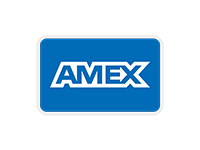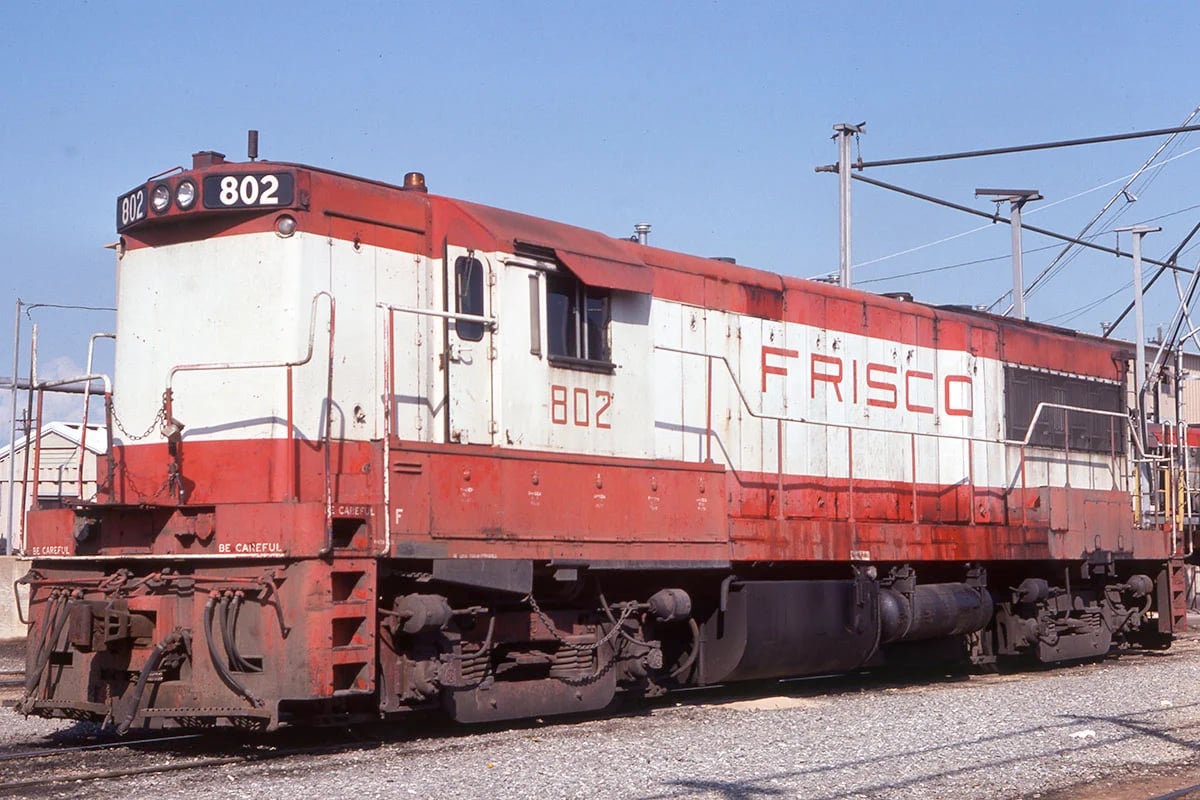
St Louis-San Francisco (Frisco) 802 – The myriad differences in the early high-hood (“high nose”) U25Bs can be seen here. Along with the high short hood, the stepwells are a radically different design than on the later engines, the handrails have an interesting high section above the stepwells and the early fuel tank, with recesses for the air reservoirs, is clearly visible. (Memphis, Tennessee – July 13, 1976) David Johnston photograph, Gregory J. Sommers collection
General Electric’s First Entry into the Domestic Road Locomotive Market
After decades producing electrical components for diesel-electric locomotives, along with offering a line of various light industrial/shortline engines (such as the 44-ton and 70-ton diesels) and export locomotives, GE began work on a road diesel aimed at the North American market. Given that there were already several builders currently building competing products, such as Baldwin, Fairbanks-Morse, this could have been a risky move by the massive corporation.
GE’s began negotiating with Cooper-Bessemer to build a new V16 diesel engine, the FDL16, to be used as the prime mover in their export locomotives, and in May 1959 a new diesel-electric locomotive with a clean-looking high-nosed hood was released from GE’s Erie, Pennsylvania, factory for testing, soon followed by another. Numbered 751 and 752, these new locomotives were designated as model XP24, or Export Test Units 2400 horsepower. As was the custom at GE, these two engines were handed off to the Erie Railroad for testing.
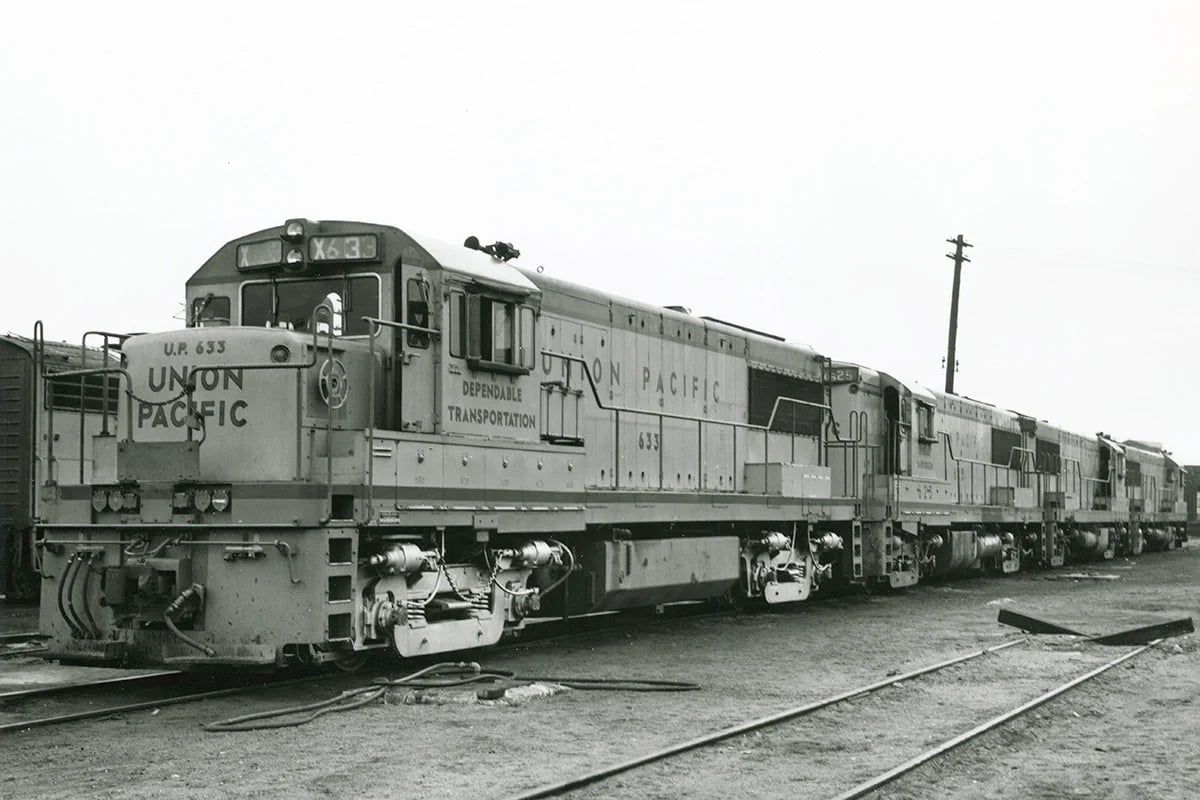
Union Pacific U25B 633 is the former General Electric demonstrator 2501. This is a unique U25B, as it has the pilots and stepwells from the early high-nosed version, but the later low-nose carbody and fuel tank. (Kansas City, Kansas – 1966) Louis Marre photograph, Gregory J. Sommers collection
These two XP24s racked up more than 100,000 miles of rigorous running, and were returned to the factory for modifications. In 1960 these two XP24s re-emerged from GE’s plant in a new paint job – blue and off-white – a higher horsepower rating – 2500-hp (thanks to the installation of GE’s GT598 generator) – and a new model designation – U25B. The carbodies, however, while similar to production U25Bs, were still the original XP24 design, which had no end platforms but featured doors in the ends to cross between units.
These two demonstrators were sent out into a railroading climate in which there were just two locomotive builders – ALCo and EMD (and their Canadian subsidiaries Montreal Locomotive Works and General Motors Diesel) – and an economic recession. Working in GE’s favor, however, was their long history of not only building electric and diesel-electric locomotives and components, but also a solid track-record of supplying components to nearly all the other locomotive builders, particularly ALCo and EMD. As a result, the big roads had some familiarity with their products. For ten months these locomotives tested on Southern, Pennsylvania, Illinois Central; Great Northern Chicago & North Western, Wabash, Frisco, Rock Island, Louisville & Nashville, New York Central Delaware & Hudson, Gulf, Mobile & Ohio and Florida East Coast.
Following GE 751 and 752’s return to GE in late 1960, four new U25B demonstrators – 753-756 – were constructed. All featured high noses, but now with end walkways. They were painted in a light gray and red scheme and toured America’s railroads beginning in march 1961. Union Pacific signed up for the first eight production units (high-nosed UP 625-628), followed by an order for Frisco for 4 (also high-nosed, SLSF 800-803), with the Frisco also purchased these demonstrators numbering them 804-807.
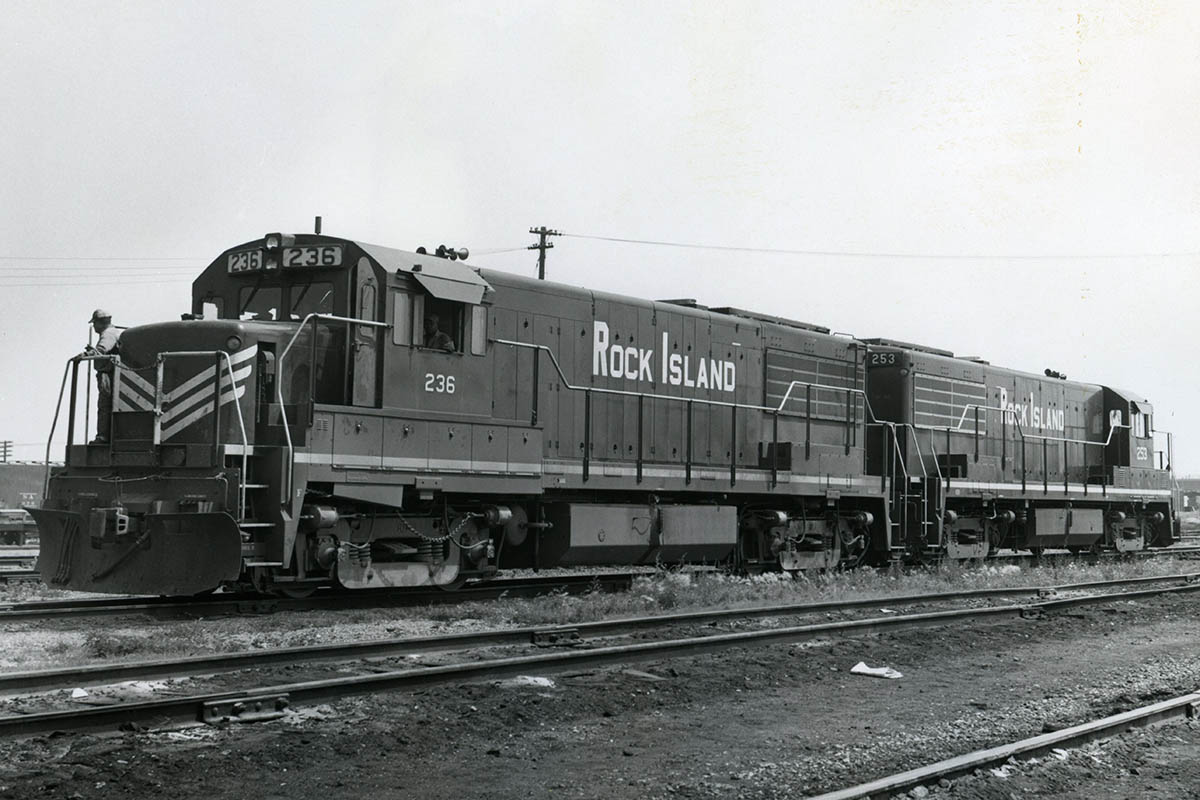
Rock Island 236 – This photo shows the Farr grilles Rock Island applied to some of their U25B radiator intakes. (Blue Island, Illinois – July 2, 1966) Louis A. Marre photograph, Gregory Sommers collection
Four new demonstrators were built in 1962. These were numbered 2501-2504 and painted in a striking red and white scheme with a large GE logo on the nose. And, speaking of noses, GE 2501 was the first low-nose U25B (with 2502-2504 being high-nosed), to see if railroads preferred the better crew visibility it provided. (Spoiler alert: They did prefer the low-nose version!). GE 2501 was unique among U25Bs, as it had the Phase I frame with the curved pilots and vertical stepwells, but the Phase II fuel tank/air reservoir and carbody. After testing, GE 2501-2504 were sold to UP (as 633-636).
Initial Success
GE received U25B orders from a number of large railroads thanks to the demonstrators’ tour. Between April 1959 and February 1966, Four-hundred seventy-eight U25Bs were constructed. Orders were placed by Santa Fe, Chesapeake & Ohio, Burlington, Milwaukee Road, Rock Island, Erie Lackawanna, Great Northern, Louisville & Nashville, New York Central, New Haven, Pennsylvania, St. Louis-San Francisco (Frisco), Southern Pacific, Union Pacific and Wabash. (Norfolk & Western, which acquired the Wabash, later purchased one U25B to replace a former-Wabash unit that was wrecked.) Many of these engines passed on to roads created through mergers, such as Burlington Northern, Norfolk & Western, Penn Central and Conrail, or were sold to other carriers, such as Rock Island’s U25Bs going to Maine Central and other roads selling a few to shortlines.
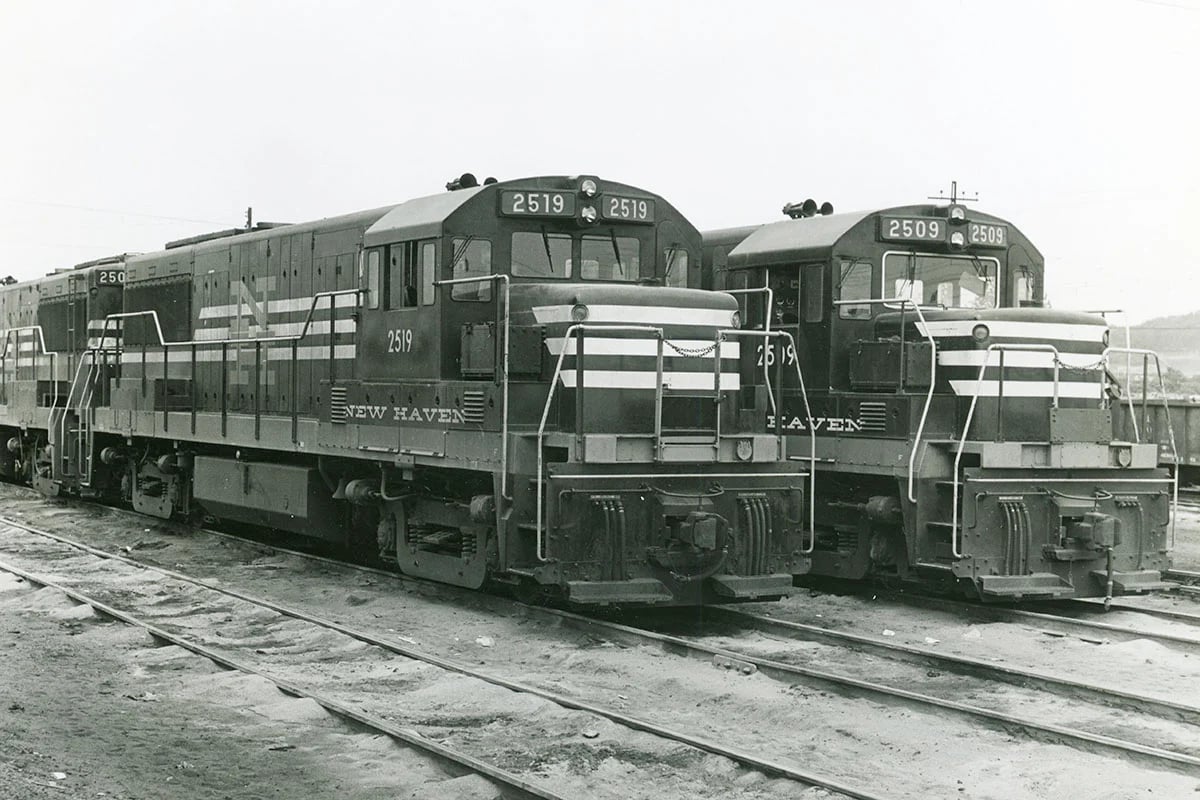
New Haven 2519 and 2509 – The two front windshields can be compared in this photo, with the early one-piece windshield on NH 2509 and the later two-piece windshields on NH 2519. Note also the early pipe-style handrail stanchions on NH 2509 and the later channel style stanchions on NH 2519. (New Haven, Connecticut – 1968) Jim Claflin photograph, Gregory J. Sommers collection
Inside the U25B
As mentioned earlier, the U25B is powered by Cooper-Bessemer’s 4 stroke, 16 cylinder FDL-16 diesel engine (and, in 1963, the FDL-16A, beginning with C&O 2515) which generates electricity to the four axle-mounted GE-752 traction motors housed in its Type B trucks. These locomotives’ power output is 2,500 horsepower, with a continuous tractive effort of 57,200 lbs. A 74:18 gear ratio allows a maximum speed of 70 miles-per-hour. The standard fuel tank holds 1700 gallons of diesel fuel. For crew comfort, optional cab equipment include 3 “Deluxe Cab Seats” (upholstered with arm rests) and an electric water cooler. GE U25Bs were originally built with 16-notch throttles, but as they “did not play well with others,” such as when MUed with EMD locomotives, before long the throttles were changed to the standard 8-notch variety. (For this reason, Rapido Trains’ U25B model replicates only the 8-notch version.)

Southern Pacific 6766 – shows a later SP unit with the typical SP accoutrements (nose light, red Gyralight on the roof, bell on the roof, friendly SP employee) – it would be a great shot if the idiotic photographer had not parked so close to the engine! (City of Industry, California – August 31, 1976) Craig Walker photograph
U25B Spotting Features
(and there are quite a few!)Frames
- Rounded Pilot (early, high nose only except for low nosed GE 2501)
- Flat Pilot (all low nosed engines, except for GE 2501)
- Pipe Stanchions, high corner railings (early, high nose)
- Pipe Stanchions, low corner railings (early, low nose)
- Channel Stanchions, low corner railings (late, low nose)
- Flat, with vertical steps cut into the sheet metal (early, high nose only except for low nosed GE 2501)
- Angled, with steps sloping inward as they get higher (all low nosed engines, except for GE 2501)
- 4-axle Type B Road Trucks
- There are some variations of the Brake Cylinders on these Trucks
- Fuel Tank with recesses on each side to accommodate Air Reservoirs (early, high nose only)
- Fuel Tank with flat side that angle toward the bottom, Air Reservoirs fore and aft of the Fuel Tank (all low nosed engines)
- Short, two high-mounted handrail stanchions, protruding steps, EAC can be mounted on either the left side, right side, or both … or neither
- Short, two high-mounted handrail stanchions, recessed steps, EAC can be mounted on either the left side, right side, or both … or neither
- Long, three high-mounted handrail stanchions, recessed steps, EAC can be mounted on either the left side, right side, or both … or neither
- Full length ladder (on engines with a short Equipment Air Cleaner, or no EAC on the left side)
- Shortened ladder (on engines with a long EAC on the left side)
- High with high-mounted Numberboards (early, high nose)
- Low with level top (low nose, early)
- Low with level top, horizontal twin light (low nose, early)
- Low with level top, horizontal twin light, brakewheel recess but no brakewheel (low nose, early)
- Low with sloping top (low nose, late)
- Mounted to front (in short hood/nose) and rear (on rear of long hood) at an outward angle – unique to U25Bs and early U28Bs
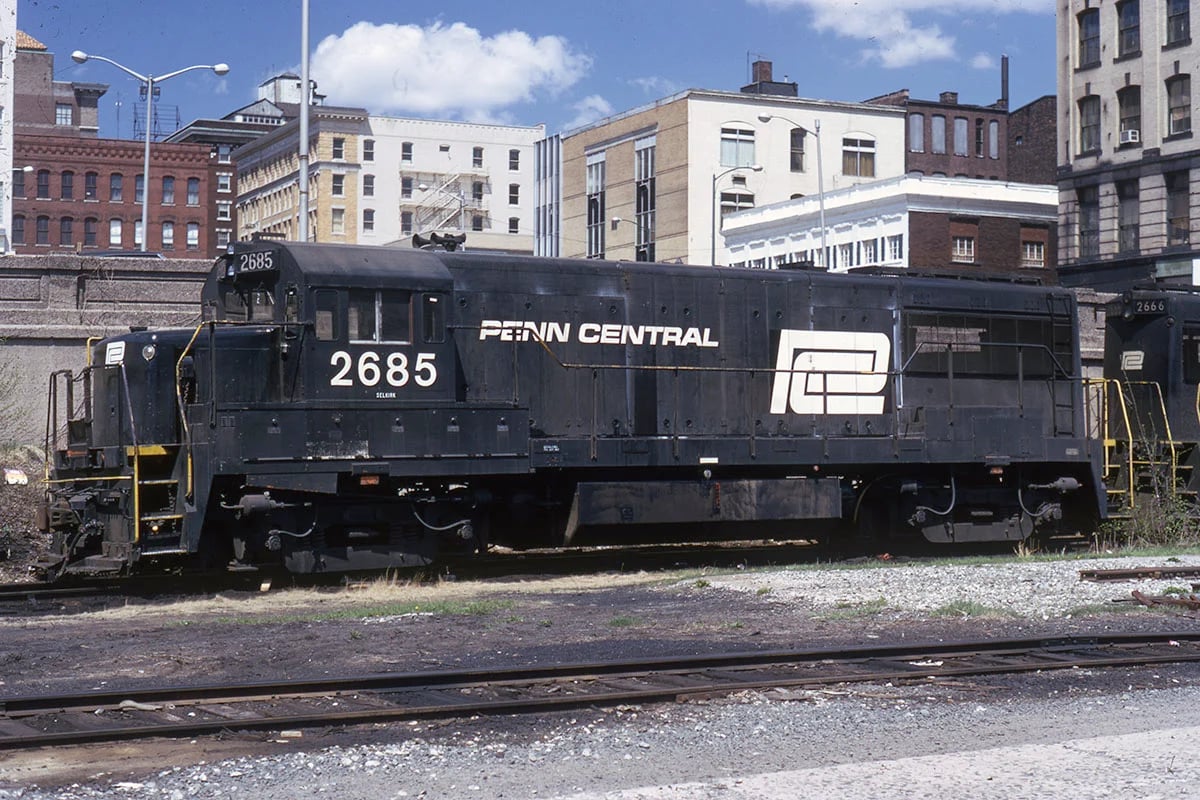
Penn Central 2685 – This low nosed engine has the later split windshield and sloped nose, but also note how transparent the radiator intake near the rear of the long hood is due to a lack of dynamic braking on this former NH unit. (Holyoke, Massachusetts – April 26, 1974) J. Snopek photograph, Gregory J. Sommers collection
Cab- No Windshield, two-pane sliding window on cab side (early, high nose)
- Large Single Pane Windshield, two-pane sliding window with two fixed windows fore and aft of the sliding window (low nose, early)
- Large Single Pane Windshield, two-pane sliding window with two plated-over fixed windows fore and aft of the sliding window (low nose, early)
- Two Small Pane Windshields, two-pane sliding window with two fixed windows fore and aft of the sliding window (low nose, late)
- Two Small Pane Windshields, two-pane sliding window with two plated-over fixed windows fore and aft of the sliding window (low nose, late)
- Dual Control Option
- Panel with short louver, tall door, short door, tall door, panel with short louver (early, high nose)
- Panel with tall louver, two large doors, panel with tall louver (low nose)
- Panel with tall louver, tall door, short door, tall door, panel with tall louver (low nose)
- Hinged panel with medium louver, louvered door, louvered door, hinged panel with medium louver (low nose)
- Long Battery Box w/ Panel with tall louver, panel with tall louver, tall door, short door, tall door, panel with tall louver (low nose)
- Long Battery Box w/ Panel with tall louver, panel with tall louver, tall door, short door, tall door, panel with tall louver (low nose)
- Long Battery Box w/ Hinged panel with medium louver, louvered door, louvered door, hinged panel with medium louver (low nose)
- Long Battery Box w/ Panel with two single louvers, tall door, short door, tall door, panel with tall louver (low nose)
- None, leaving an open Radiator Intake
- Grids are visible in the Radiator Intake behind the Screens
- Flat, wire screen
- Corrugated, holes punched in sheet metal
- Farr Stainless Steel (some Rock Island engines only)
- Stack mounted directly to roof (Early Production)
- Stack mounted in recess in roof (Mid Production)
- Tall Stack mounted in recess in roof (Late Production)
- No Numberboards
- Rear-Mounted Numberboards
- Tall Doors with High Latches
- Tall Doors with Low Latches
- Train Control Box (New Haven)
- Train Control Box (Pennsylvania)
- Trainphone Antennas (some Pennsylvania)
- Roof-Mounted Bell (Southern Pacific)
- Nose-Mounted Twin Gyralight (Southern Pacific)
- Roof-Mounted Red Gyralight (Southern Pacific)
- Farr Stainless Steel (Rock Island)
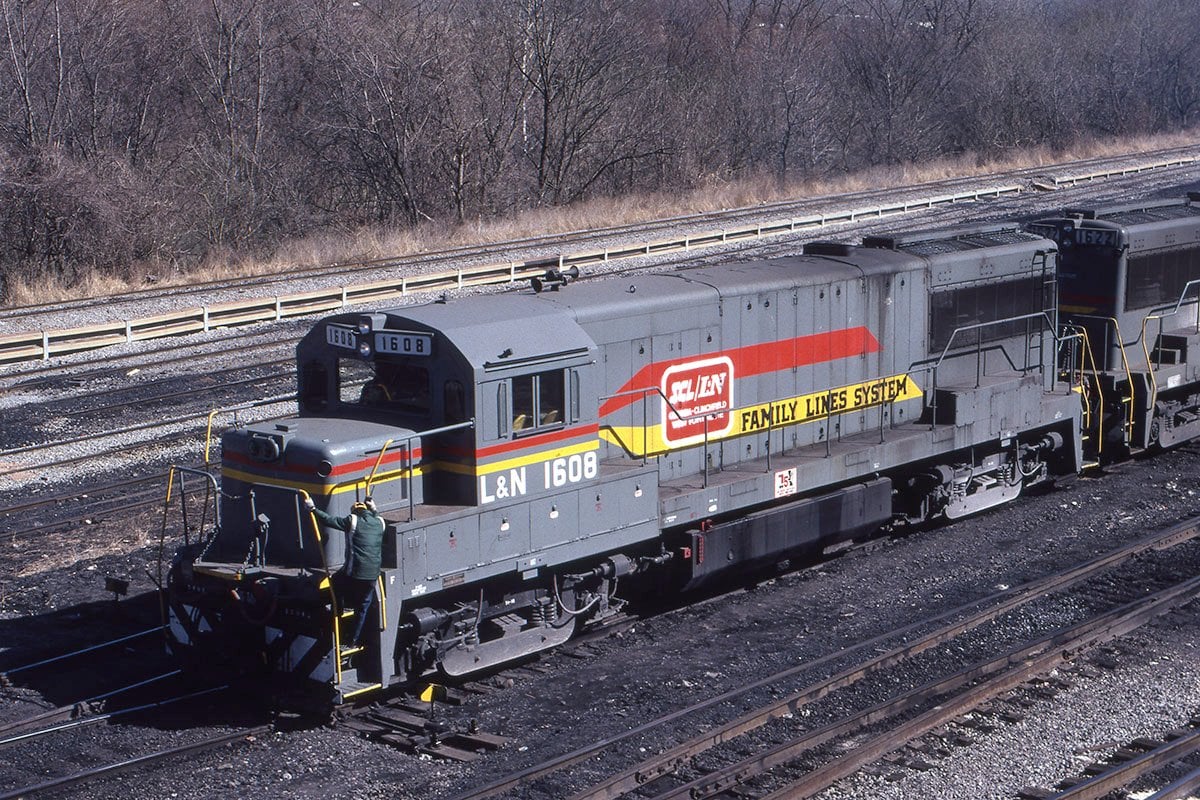
Louisville & Nashville 1608 – As seen in this elevated view, L&N 1608 shows off its nose headlight, lack of a brakewheel, plated-over cab windows, tall access doors with high-mounted upper latches, flush-mount exhaust stack and tall ladder. (DeCousey, Kentucky – March 14, 1981) Glen Koshiol photograph, Gregory J. Sommers collection
GE U25B Roster
Original Owners
| Railroad | Built | Number Series | Notes |
|---|---|---|---|
| Atchison, Topeka & Santa Fe | 1962-1963 | 1600-1615 | Later renumbered to 6600-6615 |
| Chesapeake & Ohio | 1963-1964 | 2500-2537 | |
| Chicago, Burlington & Quincy | 9/64-10/65 | 100-105 | |
| Erie Lackawanna | 1964-1965 | 2501-2527 | |
| General Electric (demonstrator | 1961 | 753-756 | Built with high nose |
| 1962 | 2501 | Built with unique low nose | |
| 1962 | 2502-2504 | Built with high nose | |
| 1962 | 51-54 | Built with low nose | |
| Great Northern | 1964-1965 | 2500-2523 | |
| Louisville & Nashville | 1964 | 1600-1627 | |
| Milwaukee Road | 380-391 | Later renumbered to 5000-5010 | |
| 6/65-8/65 | 5050-5060 | ||
| New Haven | 1964-1965 | 2500-2525 | |
| New York Central | 1964-1965 | 2500-2569 | |
| Pennsylvania Railroad | 1962, 1964-1965 | 2500-2548 | Renumbered to 2600-2658 |
| Rock Island | 1963-1965 | 200-238 | |
| St. Louis-San Francisco (Frisco) | 1961 | 800-803 | ex-GE Demonstrator, built with high nose |
| 1963-1966 | 808-831 | ||
| Southern Pacific | 1962-1964 | 7500-7567 |
|
| Union Pacific | 1961-1962 | 625-628 | Built with high nose |
| 1961 | 629-632 | ex-GE Demonstrator, built with high nose | |
| 1961 | 633 | ex-GE Demonstrator, built with unique low nose | |
| 1962 | 634-636 | Built with high nose | |
| 1962 | 637-640 | ||
| Wabash | 1962 | 500-515 |
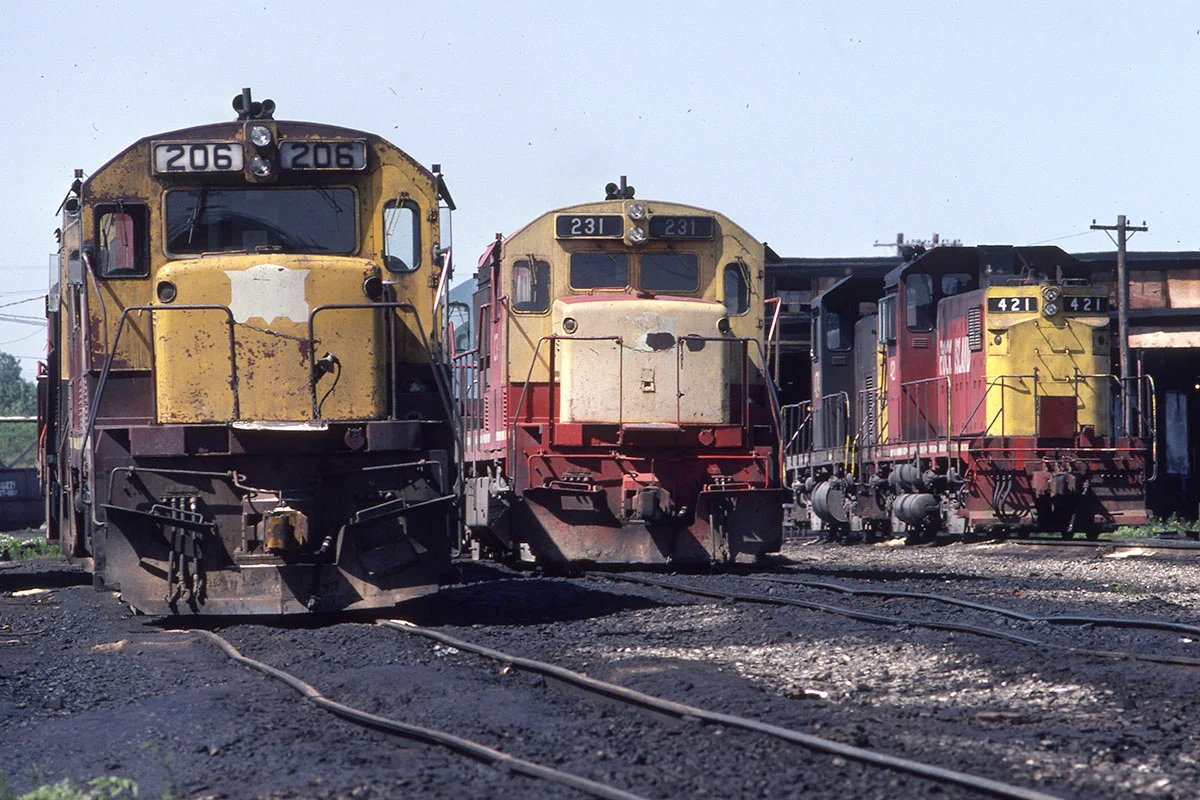
Rock Island 206 and 231 – This photos illustrates the difference between the flat and sloped short hoods (aka “noses”). (Blue Island, Illinois – July 1979) Gregory J. Sommers photograph
Subsequent Owners
| Railroad | Number Series | Former | Notes |
|---|---|---|---|
| Burlington Northern | 5210-5233 | ex-Frisco | |
| 5400-5423 | ex-Great Northern | ||
| 5424-5429 | ex-Burlington | ||
| Conrail | 2500-2569 | ex-Penn Central | |
| 2570-2596 | ex-Erie Lackawanna | ||
| 2600-2685 | ex-Penn Central | ||
| CSX Transportation | 3400-3427 | ex-Seaboard 1600-1627 | |
| General Electric (lease) | 800s | ex-Frisco, high nose units | Some units were former demos |
| Maine Central | 225-238 | ex-Rock Island | |
| Nacionales de México | 7600-7601, 7603-7614 | ex-Chesapeake & Ohio 2500-2537 | |
| Norfolk & Western | 3515-3529 | ex-Wabash | Later renumbered to 8138-8152 |
| Prairie Central | 2604-2606 | ex-Conrail 2604-2606 | |
| Penn Central | 2500-2569 | ex-New York Central | |
| 2600-2658 | ex-Pennsylvania | ||
| 2660-2685 | ex-New Haven | ||
| Pend Oreille Valley | 5057 | ex-Milwaukee Railroad 5057 | |
| Seaboard System | 1600-1627 | ex-Louisville & Nashville | |
| Vintage Locomotives | 1616 | ex-Louisville & Nashville |

Burlington Northern 5422 (ex-GN 2522) – Variations seen in this photo include the dynamic brake grids (the six staggered frames with vertical bars behind the wire mesh screen on the radiator intake), as well as the recessed exhaust stack, rear-mounted numberboards, the short equipment air cleaner, tall access doors with low-mounted upper latches, channel handrail stanchions and the GN’s distinctive air horn. (North Kansas City, Missouri – June 15, 1971)Mel Lawrence photograph, Gregory J. Sommers collection
Preserved U25Bs
- CR 2510 (ex-NYC) is located in Glenmont, NY.
- L&N 1616 is at the Southern Appalachia Railway Museum in Oak Ridge, TN.
- MILW 5056 is at the Illinois Railway Museum in Union, IL.
- MILW 5057 is being cosmetically restored for future display at South Cle Elum Rail Yard in WA.
- NH 2525 is at the Railroad Museum of New England/Naugatuck Railroad in Thomaston, CT.
- SP 3100 is at the Southern California Railroad Museum in Perris, CA.
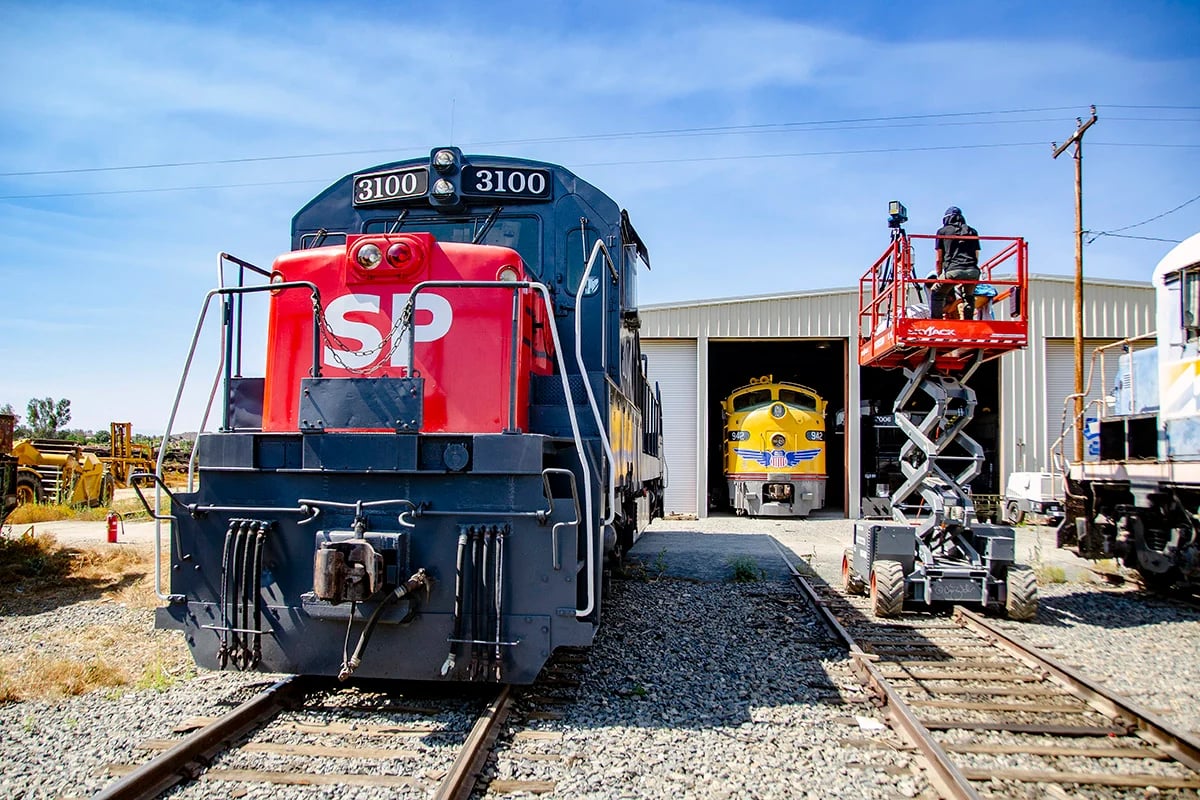
Rapido Trains Inc. spent two days at the Southern California Railway Museum measuring a pair of locomotives – SP U25BE 3100 and UP E8A 942 – in June 2020. In this photo, SP 3100 is being laser measured in order to create incredibly accurate drawings from which new molds for an HO scale model will be created. This engine was built by General Electric in March 1963 as SP U25B 7508, renumbered in 1965 to SP 6708, and rebuilt into U25BE 6800 in 1975. It was later renumbered yet again in 1979 to SP 3100 before retirement in early 1988. Orange Empire Trolley Museum (the name of this museum at that time) purchased this engine from Levin Metals in nearby Colton, saving it from the scrapper’s torch, and the museum’s volunteers performed an exemplary restoration of it, not only repainting it but restoring it to operable condition once again. And a huge “Thank you” to the SCRM’s volunteers for their hospitality as well! (Perris, California – June 10, 2020) Craig Walker photograph
U25B Notes – Things of Interest
- St. Louis-San Francisco (Frisco) purchased the first U25B, SLSF 800 (in the order for SLSF 800-803), as well as the last U25B, SLSF 831 (in the order for SLSF 824-831)
- The GE demonstrators were found on a wide variety of railroads, including those that didn’t purchase these engines, such as Rio Grande, Delaware & Hudson, Florida East Coast and others. (Early 1960s)
- Santa Fe, Milwaukee Road, Pennsylvania and Southern Pacific all renumbered at least some of their U25Bs.
- Burlington Northern, Conrail, CSX, Norfolk & Western, Penn Central and Seaboard System all acquired their U25B fleets through mergers.
- Many U25Bs were sold to new owners, such as GE demonstrators being sold to SLSF and UP, some RI engines being purchased by Maine Central following the RI’s bankruptcy, a few UP engines being rebuilt by Morrison-Knudsen and sold to Oregon Pacific & Eastern, Weyerhaeuser and Morrison-Knudsen; MILW selling some to Pend Oreille Valley; CR selling a few to Prairie Central and C&O unloading their fleet to the Nacionales de México.
- The Santa Fe and St. Louis-San Francisco (Frisco) operated run-through service between Memphis TN and Birmingham AL and Los Angeles CA. The interchange point was Floydada on SLSF subsidiary Quanah, Acme & Pacific. Chard Walker photographed eastbound ATSF train CTX on Cajon Pass with a trio of high-nosed Frisco U25Bs on the headend. (Early 1960s)
- Santa Fe leased two engines from their U25B fleet to Kennecott Copper in Utah, with ATSF 6608 becoming KCC 729 and ATSF 6611 being numbered KCC 731. (February 1975-December 1978)
- Two SP U25Bs, 6708 (ex-SP 7508) and 6724 (ex-SP 7524) were rebuilt into U25BE locomotives 6800-6801 by the SP’s Sacramento Shops in 1975. (SP 6800 was painted in Bicentennial colors.) The rebuild included changes to the roof to make it removable for ease of maintenance. SP 6800 and 6801 were later renumbered to SP 3100 and 3101. (1975-1985)
- Four SP U25Bs (SP 6745, 6717, 6733 and 6752) were extensively rebuilt by Morrison-Knudson, emerging as radically different-looking TE70-4S engines numbered 7030-7033 and wearing a bright red and orange paint job, earning them the nickname “Popsicles.” (1977-1982)
- The UP U25Bs purchased by Morrison-Knudsen (Boise ID) were rebuilt into TE53-1-4E locomotives, which bore some resemblance to their earlier U25B heritage, but there were significant body modifications in order to fit a new EMD 16-567B prime mover into them. These were later sold to the Oregon California & Eastern and Weyerhaeuser Lumber. Some were later sold to Econo-Rail and, later, Longhorn Railway. (1976+)
- The high-nose SLSF units traded in to GE were added to the lease fleet and GECX 802, 805 and 807 (at least) were leased to CR (1978)


